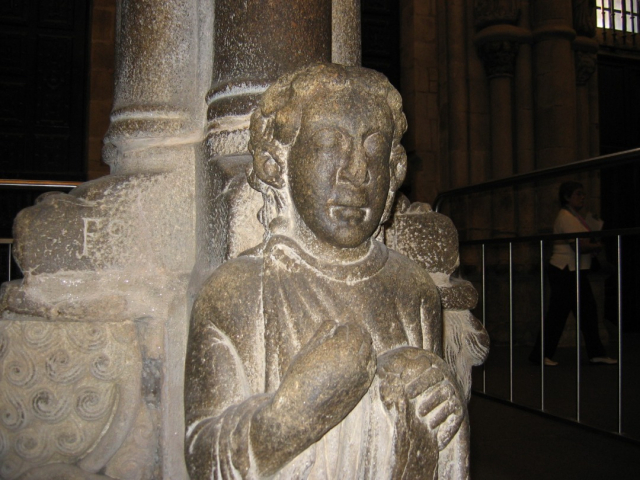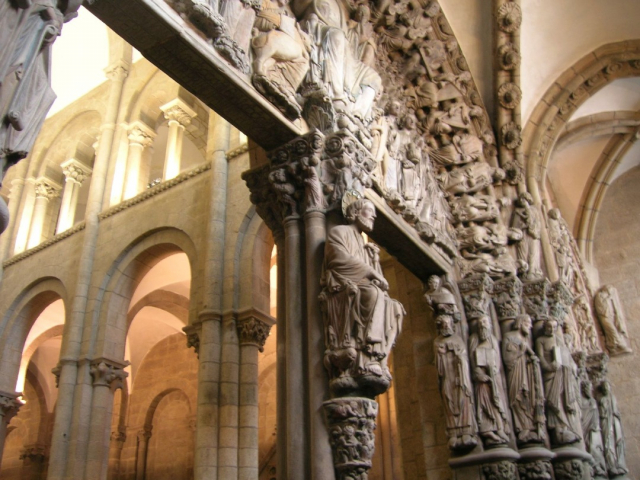Master Mateo: What you need to know about the sculptor of the Portico of Glory
The most famous artist on the Camino de Santiago led a mysterious life before directing the works of the Cathedral of Santiago
At the end of our pilgrimage and arriving at the impressive Cathedral of Santiago, we can visit the Portico of the Glory. This sculptural ensemble is the work of the artist Master Mateo, the most important figure in the history of art on the Camino de Santiago.
Why is Master Mateo so well known?
It is not known where he began to train as an architect and sculptor, but he caught the attention of King Ferdinand II of León when he was young and he commissioned him to continue the work on the Cathedral of Santiago. Mateo took charge of the work in 1168, when he was between 25 and 30 years old, with a lifetime contract and the most substantial (two silver marks a week).
Although this masterpiece of Romanesque architecture began so young, no previous works are attributed to him. This draws attention, since the fact that he was hired for one of the most important temples of Christianity, and in those conditions, seems to indicate that he was already well known before taking on this work.
The life of Master Mateo before the Cathedral of Santiago
In fact, little is known about his life prior to his work at the Cathedral. Apparently, and without any irrefutable historical evidence, he traveled and worked in France, when the first Gothic cathedrals were being built. Surely Mateo entered architecture working in the quarries, knowing the stone and its secrets in depth so that it would not fall apart when building those tall cathedrals.
This education in French Gothic fits in with his later contributions to the Cathedral of Santiago, which are mixed with others more typical of Galician Romanesque and the rest of the Peninsula. Some references to him appear in written documents. In addition to the contract he signed with Ferdinand II, a "magister Matheus" is mentioned in a carving on the lintels of the Pórtico de la Gloria, and there is a reference to him as the owner of some land in Lugo.
Popular belief recognizes the figure of “Santo dos Croques” (Saint of the Head Bumps) as the self-portrait of Master Mateo himself. It is a sculpture kneeling behind the mullion, which is given that name due to the custom of giving it a small bump on the head when passing by it. Actually, this has been denied: he is not identified with Master Mateo, but with a pilgrim who reveres the temple he is about to enter.
Master Mateo and the Cathedral of Santiago
When the direction of the works of the Cathedral of Santiago began, he was given absolute freedom. The three final sections of the main naves are attributed to him, as well as the last six sections of the galleries and the western front of the building. The latter includes the crypt, the tribune, the façade (which disappeared and was replaced by the current Obradoiro one), the two towers that flanked it and, of course, the famous Portico of the Glory. He also built the stone choir, but it is not preserved either.
The Portico of the Glory was, and still is, one of the most important monuments of the Middle Ages and of all of Christendom. It has been restored, and part of the polychromy of the figures has been recovered. In its tripartite structure several images are represented. In the central arch stands out the risen Christ and surrounded by the four evangelists and by the 24 elders of the Apocalypse. The left arch is dedicated to the Old Testament and the Jews, and the right one represents the New Testament and the Gentils.
Thanks to his designs in architecture and sculpture, we can now appreciate, eight centuries later, the artistic testimony that synthesizes the Galician and French artistic currents of the moment. His work is the culmination of the art of the Camino de Santiago, and the perfect finishing touch to an experience such as the pilgrimage to Compostela.
Routes
Blog
 ¿Vas a hacer el camino de Santiago? Cuida tus pies antes y después
¿Vas a hacer el camino de Santiago? Cuida tus pies antes y después
 5 razones por las que contratar un seguro de viajes
5 razones por las que contratar un seguro de viajes
 Formas de hacer un logotipo
Formas de hacer un logotipo
 La importancia del registro de llamadas durante tu viaje por el Camino de Santiago
La importancia del registro de llamadas durante tu viaje por el Camino de Santiago
Information
Points of interest
Cities & Towns | Hostels | Lodgings | Restaurants | Saddlery | Doctors | Points of interest | Bikes workshop
Contact us | Privacy policy | Cookies policy | | Terms of use | Authorship | Web Map | Consentimiento
© Copyright LA VOZ DE GALICIA S.A. Polígono de Sabón, Arteixo, A CORUÑA (ESPAÑA) Inscrita en el Registro Mercantil de A Coruña en el Tomo 2438 del Archivo, Sección General, a los folios 91 y siguientes, hoja C-2141. CIF: A-15000649

